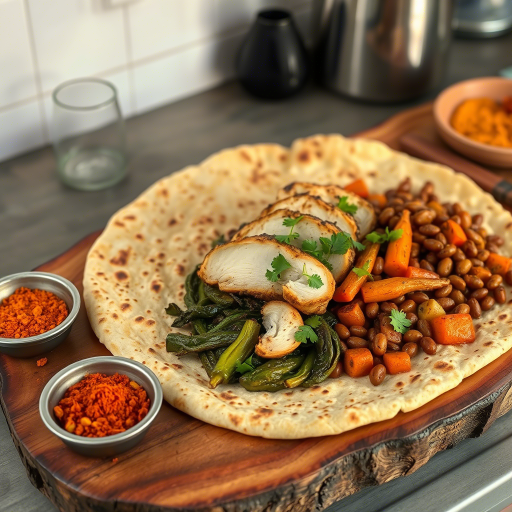
Are you tired of giving up flavor for fitness? Do you find yourself craving something that satisfies your soul but doesn’t sabotage your waistline? (Let’s be honest, we’ve all been there.) What if I told you that injera—yes, that spongy, tangy flatbread from Ethiopia—could actually become your new best friend on your weight loss journey? It might sound crazy at first glance, but hear me out. This guide will show you how to craft weight loss friendly Ethiopian injera recipes that are as nutritious as they are delicious.
And no, this isn’t just another “health hack.” Think of it more like… a culinary revolution. Imagine biting into a warm piece of injera, feeling its soft folds melt in your mouth, knowing full well that every bite is helping—not hindering—your goals. Doesn’t that sound kind of magical?
Why Traditional Injera Can Be a Double-Edged Sword
Now, let’s get real for a second. Injera has always been a star player in Ethiopian cuisine—it’s rich in iron, fiber, and cultural significance—but it can also feel like kryptonite when you’re trying to shed pounds. The fermentation process gives it that signature tang, sure, but it also means carbs galore. And don’t even get me started on portion sizes! One oversized injera can easily pack hundreds of calories.
But here’s the kicker: skipping injera altogether feels wrong, almost sacrilegious. You miss out on the texture, the aroma, the whole experience—it’s not just food; it’s an emotion wrapped in dough. So what do you do? Well, buckle up, because I’m about to spill the beans—or should I say, the teff flour.
The Game Plan: Making Injera Work For You
Alright, so how do we turn injera into a lean, mean, weight-loss machine? Here’s the deal: it’s all about tweaking ingredients, mastering techniques, and getting creative with pairings. Let’s break it down step by step.
1. Switch Up Your Flours
Traditional injera uses teff flour, which is awesome, but sometimes you need to shake things up. Enter almond flour, coconut flour, or chickpea flour—the unsung heroes of healthy baking. These alternatives bring protein, fiber, and healthy fats to the table, making your injera less carb-heavy and more satiating.
For example, I once tried swapping half the teff with almond flour, and oh man, the nutty undertones were unreal. Plus, my stomach didn’t bloat afterward, which felt like winning the lottery.
(Quick tip: Start small. If you go too wild with substitutions, you risk losing that classic injera vibe.)
Frequently Asked Question:
Can I use only alternative flours for injera?
Honestly? Yes, you totally can. But blending them with teff keeps the authenticity alive. Try substituting 50% of the teff with another flour, then tweak based on your taste buds. Experimentation is key!
2. Fermentation: The Secret Sauce
Here’s where the magic happens. Fermentation isn’t just some fancy buzzword—it’s legit science. A properly fermented batter breaks down sugars, boosts digestibility, and amps up nutrient absorption. Translation? Better gut health and fewer post-meal regrets.
I remember one time I forgot about my injera batter sitting on the counter overnight—it ended up tasting sharper than usual, but wow, was it good. Tangy, almost citrusy, like lemon zest kissed the batter. Moral of the story? Don’t rush fermentation. Patience pays off big time.
3. Pair Like a Pro
Injera alone won’t cut it—you gotta team it up with the right players. Lean proteins like grilled chicken or lentils add staying power, while veggies bring color, crunch, and antioxidants to the mix. Picture this: a plate piled high with sautéed greens, roasted carrots, and spiced cabbage, all nestled atop a perfectly cooked injera. It’s basically art, right?
Oh, and here’s a fun fact: berbere spice blends (those fiery red powders) aren’t just for heat—they’re loaded with anti-inflammatory goodness. Sprinkle generously!
Quick Tips for Crushing It
- Portion Control Is Everything : Seriously, don’t overdo it. Stick to smaller servings—think 6–8 inches max—to avoid calorie overload.
- Spice It Up : Turmeric, ginger, garlic—they’re not just tasty; they’re basically superfoods in disguise. Bonus points if you grow fresh herbs in your kitchen window.
Real Talk: Common Concerns
Can I Still Enjoy Injera If I’m Gluten-Free?
Duh, yes! Teff flour is naturally gluten-free, so you’re golden. Just double-check any additional flours you toss in.
Will Healthier Injera Taste Weird?
Look, it might not taste exactly like grandma’s recipe, but trust me, it’ll still hit the spot. The spices and fermentation make up for any texture differences. Honestly, after a few bites, you won’t even notice.
Wrapping It Up
So there you have it—a roadmap to guilt-free injera indulgence. By switching flours, perfecting fermentation, and pairing smartly, you can enjoy this iconic dish without the guilt trip. Sure, it takes a little effort, but isn’t anything worth having supposed to?
Go ahead, give it a shot. Whip up a batch tonight, snap a pic, and tag #WeightLossInjera—I wanna see your creations! Who knows? Maybe you’ll inspire someone else to join the movement.
Life’s too short to skip the foods you love. With these tweaks, injera doesn’t have to be the villain—it can be the hero of your story.
